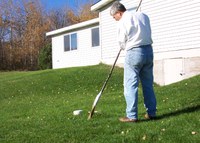Pump Your Septic Tank Before Winter Hits
(Click the image below to view a high-resolution image that can be downloaded)
Now is a good time to have septic tanks cleaned and pumped, according to a North Dakota State University Extension Service agricultural engineer.
Septic tanks with too much accumulated sludge and other material can cause problems in the winter. Fixing a failed septic system in cold weather is difficult and expensive.
“Cleaning the accumulated solids - sludge - from the septic tank is the most common, routine maintenance needed for most individual home sewage treatment systems,"" says Tom Scherer, Extension water quality and irrigation expert.
Most septic tanks need cleaning about every three years, he says. However, the actual time will depend on the quantity of solids entering the tank. The tank may have to be cleaned every one or two years if the home has a garbage disposal in the kitchen sink, which significantly increases a septic tank’s solids loading.
The septic tank’s main purposes are to separate solids from liquids, allow bacteria to break down the solids and store the nondegradable solids until they can be removed. The drainfield provides additional bacterial degradation of the effluent from the septic tank and allows the effluent to infiltrate the soil. The bacteria that do this work, in both the septic tank and drainfield, are common soil bacteria.
As sewage breaks down in the septic tank, some solids settle to the bottom and others float to the top. This separation usually produces three distinct layers, which are:
- Top - Scum composed of cooking fats and oils, soap byproducts and products of decomposition are lighter than water and float to the top
- Middle - This consists of water containing very small pieces of waste; it's the effluent that is discharged to the drainfield.
- Bottom - Sludge composed of decomposition byproducts and other materials is heavier than water and sinks to the bottom.
On many farms, a fair portion of the sludge is the dirt that comes from washing clothes.
If you are not sure when the septic tank was cleaned last, you can measure the depth of sludge in the tank to determine whether the tank needs to be cleaned. To do that:
- Wrap 3 or 4 feet of white terry cloth or toweling, rough side out, around a wooden or metal pole. The pole should be long enough to reach to the bottom of the septic tank.
- Slowly push the pole to the bottom of the tank through an inspection pipe or the manhole. The best place to measure is under the inspection pipe at the inlet to the septic tank because the sludge layer will be thickest there.
- Turn the pole slowly three to five revolutions, let it sit for a minute, then slowly withdraw it.
Where the black particles cling to the rough cloth determines the sludge thickness. If the sludge thickness is greater than 12 inches, have the tank cleaned, Scherer advises.
He also recommends that a licensed contractor pump the septic tank. Cleaning a tank is more than just pumping out the liquid. Pumping and back-flushing the liquid into the tank several times will break up the scum and sludge layers. The contractor then can pump the mixed contents from the tank and dispose of them in an approved method.
The only way to clean a septic tank effectively is through the manhole, not the inspection ports, Scherer says. Inspection ports are the 4- or 6-inch-diameter pipes that come to the surface over the septic tank’s inlet and outlet baffles. Cleaning a septic tank through the manhole provides the pumper enough room to move the suction pipe to various corners of the tank and also see the condition of the tank.
Cleaning and pumping through the inspection ports can damage or break the inlet and outlet baffles, and the openings are too small to see the condition of the tank. Breaking the baffles can prevent free movement of effluent in and out of the septic tank and lead to the drainfield becoming plugged.
“Pumping a septic tank on a regular basis is much cheaper than using septic system additives and is much more effective,” Scherer says.
Although septic system additives have been sold since the 1880s, and more than 120 products that claim to improve septic system operations are on the market, 80-plus years of research has not found evidence that they work. In fact, some have been found to pollute groundwater.
Scherer suggests that if people put additives in their septic system, they should read the directions very carefully. They also should make sure the additive is recommended for the problem they’ve noticed.
For more information on septic systems, go to publication AE-892, “Individual Home Sewage Treatment Systems.” It’s available at county Extension offices or online at http://www.ag.ndsu.edu/pubs/ageng/structu/ae892.pdf.
NDSU Agriculture Communication
| Source: | Tom Scherer, (701) 231-7239, thomas.scherer@ndsu.edu |
|---|---|
| Editor: | Ellen Crawford, (701) 231-5391, ellen.crawford@ndsu.edu |


